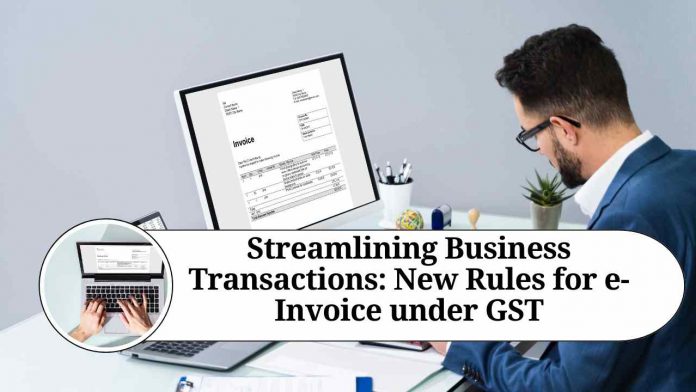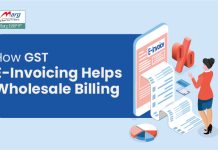Recent Updates on e-Invoicing:
10th May 2023
The CBIC announced that starting from August 1st, 2023, businesses with a turnover of ?5 crore or above since 2017-18 will be mandated to generate e-invoices as part of the 6th phase of e-invoicing implementation. This decision aligns with the government’s vision of promoting a digital economy.
Introduction
In a constant effort to simplify and streamline tax compliance procedures, the Goods and Services Tax (GST) Council in India has recently introduced new rules for e-invoicing. E-invoicing, or electronic invoicing, is an electronic mechanism for generating and reporting invoices directly to the GST portal. These new rules aim to enhance the efficiency, transparency, and accuracy of invoicing processes, benefiting both businesses and the government. In this blog, we will explore the key aspects of the new e-invoice rules under GST and their impact on businesses.
What is e-Invoice?
E-invoice is a standardized digital format of an invoice that contains the same information as a traditional paper invoice. It is generated and stored electronically in a centralized system approved by the GST Network (GSTN). E-invoices have a unique Invoice Reference Number (IRN) and a Quick Response (QR) code that facilitates easy verification and tracking.
Scope and Applicability:
The new e-invoice rules apply to businesses with an annual turnover exceeding INR 500 crores in any financial year. These businesses are required to generate e-invoices for all their business-to-business (B2B) transactions.
Generating e-Invoice:
To generate an e-invoice, businesses need to integrate their invoicing software or enterprise resource planning (ERP) system with the GSTN’s Invoice Registration Portal (IRP). The IRP will validate the invoice data and assign a unique IRN to each invoice. The e-invoice must contain specific mandatory fields as prescribed by the GSTN.
QR Code and IRN:
Every e-invoice generated under the new rules must have a QR code containing key details such as the IRN, supplier’s GSTIN, recipient’s GSTIN, invoice number, invoice date, and other relevant information. This QR code enables easy offline verification of the invoice’s authenticity.
Reporting to GST Portal:
Businesses must report e-invoices to the GST portal in real-time. The e-invoice details are auto-populated in the GST returns, eliminating the need for separate data entry. This integration simplifies compliance and reduces the chances of errors and mismatches in the invoicing and reporting process.
Impact on Businesses:
The new e-invoice rules offer several advantages for businesses, including:
a. Reduced Compliance Burden: By automating the invoicing and reporting process, businesses can significantly reduce the time and effort involved in manual data entry, thereby minimizing compliance-related errors.
b. Improved Efficiency: E-invoicing eliminates the need for physical documentation, streamlines data management, and ensures faster processing of invoices, leading to increased operational efficiency.
c. Enhanced Data Accuracy: The standardized format of e-invoices reduces the risk of data entry errors and inconsistencies, ensuring accurate reporting and reconciliation of invoices.
d. Better Cash Flow Management: With e-invoicing, businesses can track the status of their invoices in real-time, allowing for better cash flow management and faster payment cycles.
Challenges and the Way Forward:
While the implementation of e-invoice under GST brings significant benefits, businesses may face initial challenges in adapting to the new system. Some common challenges include technological integration, training employees, and ensuring compatibility with different ERP systems. However, with time and proper guidance, these challenges can be overcome.
The government has been proactive in addressing concerns and providing support to businesses during the transition. It is essential for businesses to stay updated with the latest guidelines and leverage technology solutions to ensure a smooth transition to e-invoicing.
Conclusion
The introduction of new e-invoice rules under GST marks a significant step towards simplifying and digitizing the invoicing process in India. The move aims to improve compliance efficiency, reduce tax evasion, and foster a transparent business environment. Businesses should embrace this transformation and leverage the benefits of e-invoicing to enhance their operational effectiveness, streamline processes, and comply with the GST regulations more effectively.
Read more useful content:
Frequently Asked Questions (FAQs)
Q. What is e-invoicing?
E-invoicing is the process of generating and reporting invoices electronically in a standardized digital format. It involves the creation of invoices in a specific format approved by the GSTN and reporting them directly to the GST portal.
Q. Who needs to comply with the new e-invoice rules?
Businesses with an annual turnover exceeding INR 500 crores in any financial year are required to comply with the new e-invoice rules. They need to generate e-invoices for their business-to-business (B2B) transactions.
Q. What is the purpose of introducing e-invoice under GST?
The introduction of e-invoice under GST aims to simplify and streamline the invoicing process, enhance compliance, reduce errors, and promote transparency in business transactions. It also facilitates seamless integration of invoice data with GST returns, making the overall tax compliance process more efficient.
Q. How do I generate e-invoices?
To generate e-invoices, you need to integrate your invoicing software or ERP system with the GSTN’s Invoice Registration Portal (IRP). The IRP will validate the invoice data and assign a unique Invoice Reference Number (IRN) to each invoice.
Q. What information should an e-invoice contain?
An e-invoice should include mandatory fields such as the supplier’s GSTIN, recipient’s GSTIN, invoice number, invoice date, item details (including HSN codes), quantity, value, tax amounts, and other relevant information. The specific fields and format are prescribed by the GSTN.
Q. What is the QR code in an e-invoice, and why is it important?
The QR code in an e-invoice contains key details such as the IRN, supplier’s GSTIN, recipient’s GSTIN, invoice number, invoice date, and other relevant information. It enables offline verification of the invoice’s authenticity, making it easier for the recipient and tax authorities to validate the invoice.
Q. Do I still need to maintain physical copies of invoices?
As per the new e-invoice rules, there is no requirement to maintain physical copies of invoices specifically for GST purposes. However, it is advisable to retain electronic copies or backups of invoices for record-keeping and audit purposes.
Q. How does e-invoicing impact the GST return filing process?
E-invoicing simplifies the GST return filing process by automatically populating the e-invoice details in the GST returns. This integration reduces the need for manual data entry, minimizes errors, and ensures consistency between invoicing and reporting.
Q. What are the benefits of e-invoicing for businesses?
Some key benefits of e-invoicing for businesses include reduced compliance burden, improved efficiency, enhanced data accuracy, better cash flow management, and faster payment cycles. It also enables seamless integration with ERP systems and provides real-time visibility of invoice status.
Q. What are the challenges businesses may face while implementing e-invoicing?
Businesses may face initial challenges in integrating their existing systems with the IRP, training employees to adapt to the new process, and ensuring compatibility with different ERP systems. However, with proper guidance, these challenges can be overcome, and businesses can reap the benefits of e-invoicing.




















